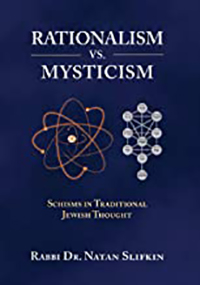By Rabbi Dr. Israel Drazin

 BOCA RATON, Florida — Many Jews would like to find an easy way to learn what Judaism teaches about various subjects. Rabbi Dr. Natan Slifkin, an Orthodox rabbi, gives them this information in his fact-filled book Rationalism vs. Mysticism: Schisms in Traditional Jewish Thought, with quotes from many sources and many learned footnotes, all easy to read.[1]
BOCA RATON, Florida — Many Jews would like to find an easy way to learn what Judaism teaches about various subjects. Rabbi Dr. Natan Slifkin, an Orthodox rabbi, gives them this information in his fact-filled book Rationalism vs. Mysticism: Schisms in Traditional Jewish Thought, with quotes from many sources and many learned footnotes, all easy to read.[1]
Readers will be surprised to learn that there are Jews who are rational in their thinking and those who tend to mysticism and each feels they understand Judaism in its authentic traditional manner even though each has ideas and practices that some might say is as different as two unlike religions.[2]
They may also be surprised to discover that there were historical periods when rationalism predominated Jewish thought and others when mysticism prevailed. They may be amazed to learn that Chazal, the highly respected ancient rabbis, were lots of different people living over different periods in different places with different ideas. So too they may be amazed to learn that the great rational thinker Maimonides did not believe that the ancient rabbis were infallible. They will find Slifkin’s book, which is factual and correct, to be eye-opening and thought-provoking. While he is a rationalist, he does not disparage mysticism.
Some of the many differences between rationalism and mysticism are:
- Rationalists contend that it is proper to obtain knowledge through reasoning, science and the senses. Mystics insist that the human mind is fallible and depend on obtaining facts only through revelation and the teachings of pious mystical rabbis. Mystics are discouraged from ever disagreeing with Torah scholars of renown.
- Mystics insist that there has been a decline in intelligence since ancient times. We in the 21st century are like donkeys compared to the ancient rabbis. Rationalists deny this claim.
- Rationalists value natural interpretation of events rather than supernatural. Mystics explain that events occurred because of miracles. Most mystics assert that miracles occurred in the past and many say they happen today as well although they are not clearly visible.
- Mystics believe in the existence of supernatural entities working in our lives such as angels, astrological forces, divine sefirot (emanations), demons, and evil spirits, which rationalists reject.
- Mystics declare that magic works but Jews are forbidden to use it; they must rely on God. Rationalist do not accept this idea.
- Rationalists consider the Torah to be a divine instruction book for human life, to improve a person’s mind and character, and society. Mystics see Torah study possesses all kinds of metaphysical powers including affecting God, changing God’s plans, and maintaining the existence of this world, which will cease to exist when there is no one studying the Torah.
- Mystics feel certain that “divine providence” means that God is present in the life of every human and when necessary God changes a person’s circumstances. In contrast, Maimonides taught that divine providence is the intellect that God placed in humans. He advised people to use their intellect at all times and not rely on God. Thus prayer is not a petition for divine intervention. The Hebrew word l’hitpaleil, usually translated as “to pray,” literally means “to judge one’s self,” to reflect, and to use our intelligence and the prayers to inspire us to improve ourselves and society.
- Mystics see the Messianic Era as a magical period. Maimonides stressed that the term implies a period of peace with human life and nature being unchanged.
- Mystics are convinced that the land of Israel and the Hebrew language have magical powers a claim rationalist do not accept.
- Mystics also claim that Jews have a special superior nature far unlike that of other people, a claim rationalists rebuff.
These are just some of the differences between rationalists and mystics which Rabbi Dr, Slifkin discuses in the 129 pages of the first part of his book. In the 356 pages of part two, he delves more deeply into 14 interesting subjects. Among them are Maimonides’ view of miracles, the sages’ powers over life and death, wrestling with demons, and what can one do for the deceased.
The book is supplemented with two other discussions in two appendices. The first is: What must a Jew believe? The second is: The authenticity and authority of the mystical book Zohar.
In short, as previously stated, Rabbi Slifkin gives his readers a wealth of interesting thought provoking information that his readers will really appreciate.
*
NOTES
[1] I, Israel Drazin, think of rationalists as focusing on human lives and this earthly world, while mystics focus on God and the next world. For example: I was taught in the yeshiva that we should know that this world is an entryway to the world to come and focus on moving to the latter. Another example: the mystic Nachmanides taught that pious Jews should not use doctors but depend on God for their healing.
[2] Of course one rationalist may have some ideas that differ with other rationalists and may even mix some mystical ideas into his or her rational thoughts. The same with mystics. Abraham ibn Ezra, for example, was a rationalist but believed in the power of astrology. When speaking of rationalists and mystics we mean people whose main inclination is to rationalization or mysticism. Similarly, when speaking of mysticism, non-rationalists who may not openly identify with mysticism can be included if they have some mystical ideas.
*
Rabbi Dr. Israel Drazin is a retired brigadier general in the U.S. Army chaplain corps and the author of more than 50 books.